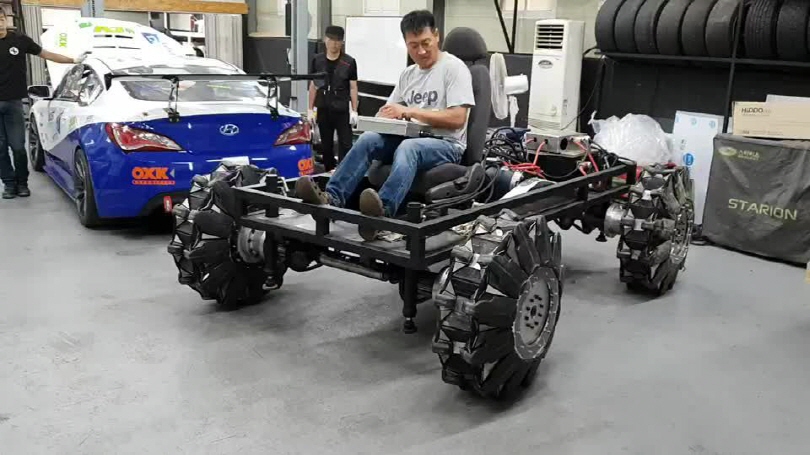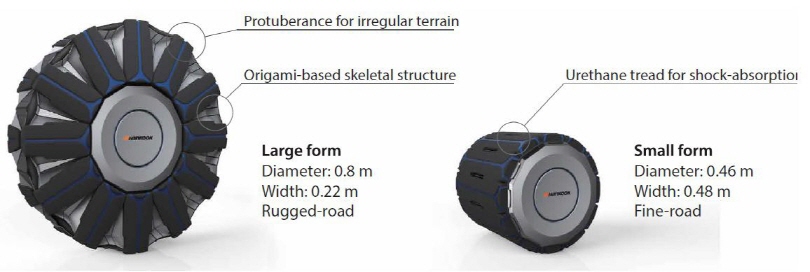Department News
[Chosun Ilbo] Prof. Kyu-Jin Cho’s Research Team Develops ‘Transformer Tire’ That Adjusts to Road Conditions
Author
관리자
Date
2021-04-12
Views
1435
Doubling Size Irregular Terrain – The Creators Behind Transformable Tire
[Science Shot] Joint research between SNU, Harvard, and Hankook Tire
 Transformable tires changing shape according to road conditions. The wheel’s radius is smaller flat roads but grows larger irregular terrain, making it easier to roll over obstacles. /SNU
Transformable tires changing shape according to road conditions. The wheel’s radius is smaller flat roads but grows larger irregular terrain, making it easier to roll over obstacles. /SNU Transformable tires changing shape according to road conditions. The wheel’s radius is smaller flat roads (left) but grows larger irregular terrain, making it easier to roll over obstacles. /Science Robotics
Transformable tires changing shape according to road conditions. The wheel’s radius is smaller flat roads (left) but grows larger irregular terrain, making it easier to roll over obstacles. /Science RoboticsA car running asphalt suddenly faces an unpaved road. At that moment, its wheels grow larger in size, the car easily climbing over a rock blocking the road. Transformable tires seen in movies and advertisements were recently developed by a Korean research team. Transformable tires can be installed in cars operating in harsh road conditions, and lunar and Mars rovers.

Transformable tire that changes shape according to road conditions./SNU
On April 7th, a joint research team of Prof. Kyu-Jin Cho of SNU Dept. of Mechanical Engineering, Dr. Dae-Young Lee, postdoctoral researcher at Harvard University, and Chang-Young Sohn, chief researcher at Hankook Tire announced the development of a transformable tire that changes shape according to road conditions. The tire has been tested ae-ton vehicle.
The radius of the transformable tire remains at 46cm while running flat roads. But when it reaches irregular terrain, the force of the motor pulls the axis, lengthening the radius to 80cm. The width of the tire narrows from 48cm to 22cm, while the radius increases.
“The size of an obstacle that a vehicle can climb over is proportional to the length of the wheel’s radius,” explained Prof. Cho. “As the wheels grow larger, protrusions(??) appear the surface, which makes the ability to overcome obstacles also gets better in proportion.”
 Transformable tire developed by SNU and Hankook Tire. The wheels remain at a smaller size smooth roads (right) but grow larger unpaved roads (left). / Science Robotics
Transformable tire developed by SNU and Hankook Tire. The wheels remain at a smaller size smooth roads (right) but grow larger unpaved roads (left). / Science Robotics◇Making transformable wheels with origami methods
The research team designed the transformable tire using origami methods, which can turn a flat surface like paper to a three-dimensional structure. Aluminum pieces, typically used in airplanes, were attached to nylon fabric that goes into tire construction. Just like origami, a three-dimensional tire is constructed by folding the fabric between the aluminum pieces. Polyurethane was applied the outside to absorb shock.
The team suggested that transformable tires could be used in areas where mobility is needed in an unpredictable environment, such as indoor service robots wheels, delivery robots, and space rovers.
According to Bon-Hee Ku, Senior Managing Director at Hankook Tire & Technology, this was “a case in which original ideas from the university met the technology of our company to create synergy.” Prof. Choi said: “We will conduct follow-up research with Hankook Tire. We hope our transformable tires will be used in Korean lunar rovers in the future.”
 Transformable tire changing shape, developed by SNU and Hankook Tire. Reaching an uneven surface, the radius of the tire increases while the width decreases. /Science Robotics
Transformable tire changing shape, developed by SNU and Hankook Tire. Reaching an uneven surface, the radius of the tire increases while the width decreases. /Science RoboticsThe team plans to replace the aluminum plates with carbon fibers, and the fabric with stronger material such as Kevlar or Dyneema, thereby making it lighter and improving its durability.
The research was published the international journal Science Robotics as the cover of its April issue. Jae-Kyeong Kim, Ph.D. student at SNU, and Jeong-Mu Heo from Hankook Tire were also listed as co-authors.
Original article https://www.chosun.com/economy/science/2021/04/08/LAS5EQCU7VGFDGD5XF3K6HERBY/?utm_source=naver&utm_medium=referral&utm_campaign=naver-news

